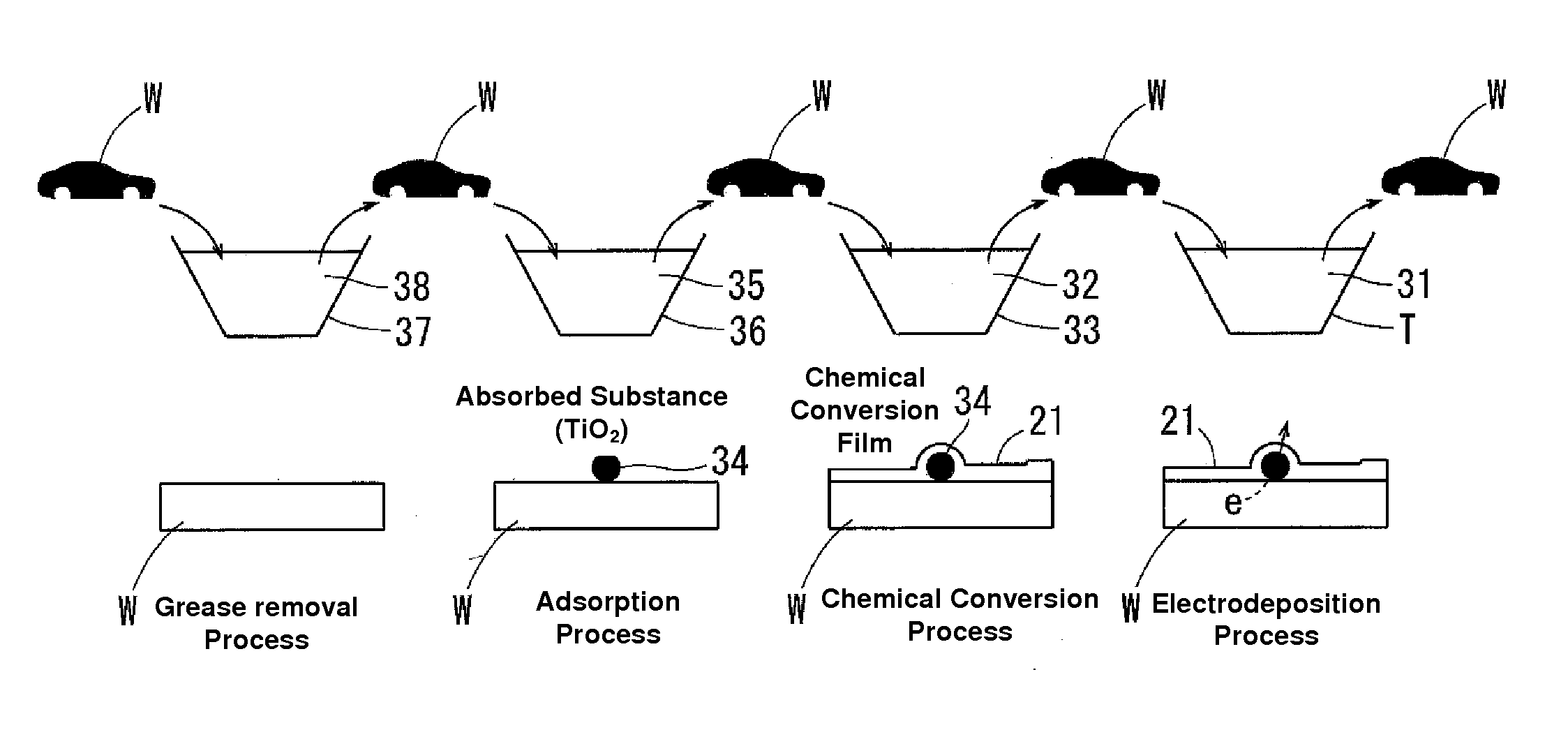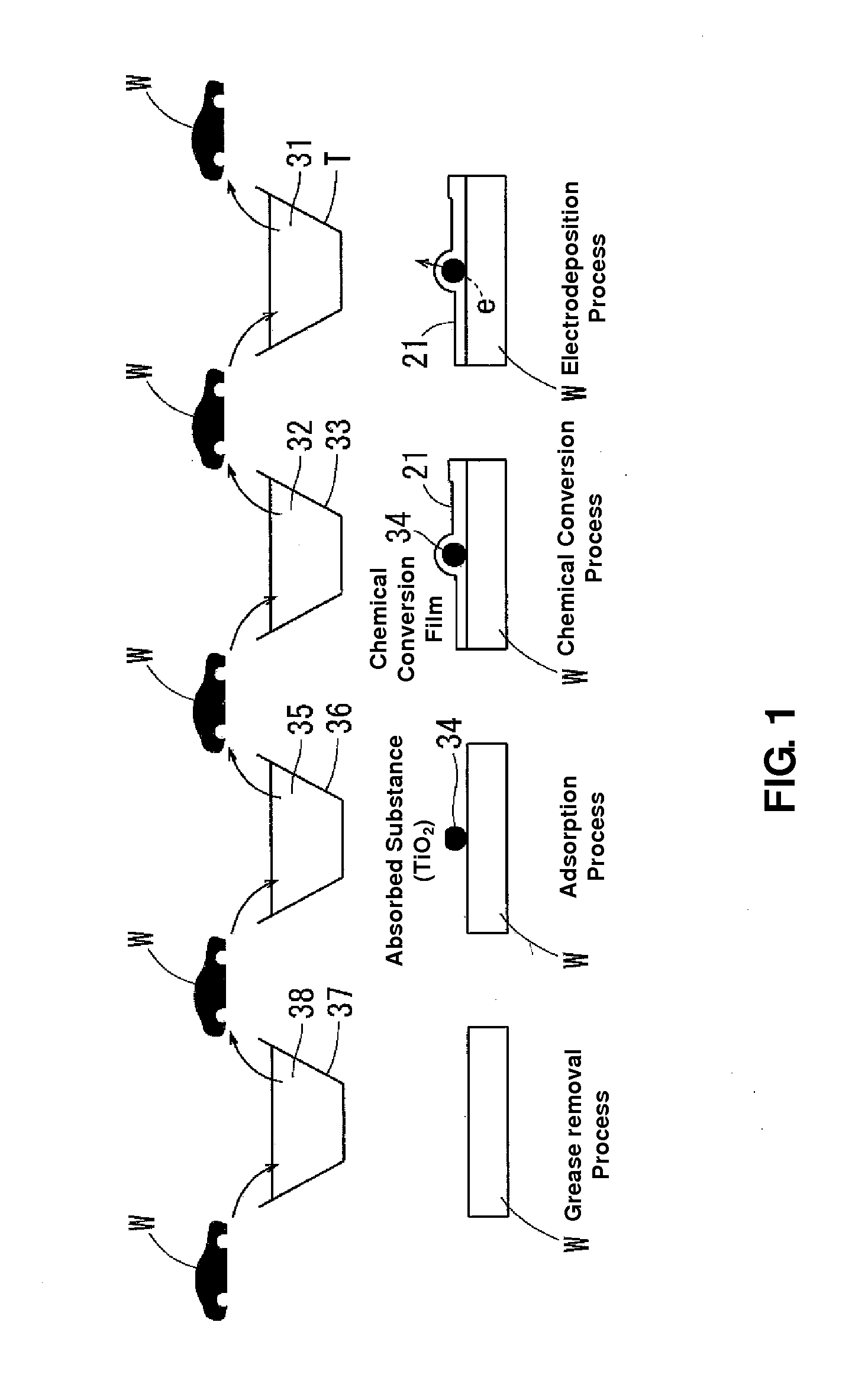Surface treatment method of metal material
a surface treatment method and metal material technology, applied in the direction of electrophoretic coating, solid-state diffusion coating, coating, etc., can solve the problems of sludge production waste, improper deposition of coating film in the portion of the workpiece, etc., to improve the effect of electrodeposition coating
- Summary
- Abstract
- Description
- Claims
- Application Information
AI Technical Summary
Benefits of technology
Problems solved by technology
Method used
Image
Examples
embodiment 1
[0055]In a coating process of a vehicle body W of automotive vehicles or the like, as shown in FIGS. 1 and 2, an electrodeposition coating process is applied as a final one. This electrodeposition coating process is a process of a cationic electrodeposition coating (undercoating) being applied to the vehicle body W, where the vehicle body W is immersed in a cationic electrodeposition coating material contained in a tank T (for the period of time 180 sec. for example), and then a voltage is applied between the tank T and the vehicle body W under a condition that the tank T and the workpiece W are set as an anode and a cathode, respectively. As a result, a coating film (not illustrated in FIG. 1) is deposited on the surface of the workpiece W.
[0056]A chemical conversion film forming treatment (hereinafter, referred to as “chemical conversion process”) is applied before the above-described electrodeposition coating process in the coating of the vehicle body W as shown in FIG. 1. This i...
embodiment 2
[0091]FIGS. 19 through 25 show a second embodiment of the present invention. Herein, the n-type ZnO as n-type semiconductor fine particles was used as the electron releasing substance to be adsorbed in the adsorption process, and it was contained in the ZrO2 film 21 through the chemical conversion process to make a developed film of the present embodiment. In this example, the content ratio of the n-type ZnO to the ZrO2 film 21 was 5.6 mass %, and the n-type ZnO had the following composition and characteristics:[0092]Composition: Ga-Doped ZnO[0093]Volume resistivity: 20 to 100 (Ω·cm)[0094]Specific surface area: 30 to 50 (m2 / g)[0095]Average particle size (primary particle size): 20 to 40 (nm)
[0096]According to the results of FIG. 19, the coating-film thickness characteristic (electrodeposition coatability) of the ZrO2 film containing the n-type ZnO (semiconductor fine particles) became similar to that of the zinc phosphate film 1. This is because it can be considered that in case the...
embodiment 3
[0100]A third embodiment, which is shown in FIG. 26, shows manufacturing processes, in which a doping treatment of an electron releasing-related substance which is adsorbed in the adsorption process is applied to a chemical conversion film before the electrodeposition coating process and thereby the chemical conversion film is formed on the n-type semiconductor. In the third embodiment, an electron releasing-related substance which has a greater electric charge number than the chemical conversion film (Zr) was used and it was adsorbed into the vehicle body W in the adsorption process. Then, the vehicle body W was heated (anneal treatment) in a heating process which is before the electrodeposition coating process and after the chemical conversion process, so that a doping treatment of the electron releasing substance was applied to the chemical conversion film. Specific manufacturing conditions were as follows:
(i) Electron releasing substance: Ti, Zn as a metal, an oxide of which bec...
PUM
| Property | Measurement | Unit |
|---|---|---|
| time | aaaaa | aaaaa |
| energy band gap | aaaaa | aaaaa |
| conductive | aaaaa | aaaaa |
Abstract
Description
Claims
Application Information
 Login to View More
Login to View More - R&D
- Intellectual Property
- Life Sciences
- Materials
- Tech Scout
- Unparalleled Data Quality
- Higher Quality Content
- 60% Fewer Hallucinations
Browse by: Latest US Patents, China's latest patents, Technical Efficacy Thesaurus, Application Domain, Technology Topic, Popular Technical Reports.
© 2025 PatSnap. All rights reserved.Legal|Privacy policy|Modern Slavery Act Transparency Statement|Sitemap|About US| Contact US: help@patsnap.com



